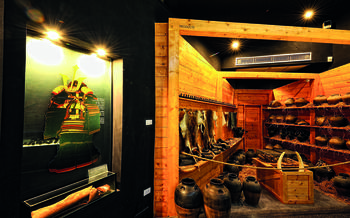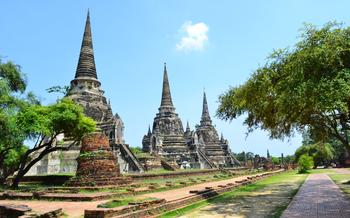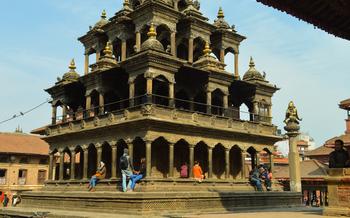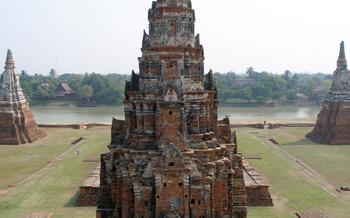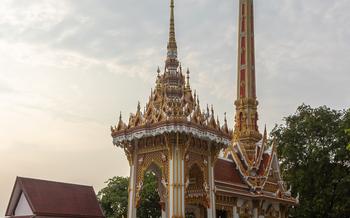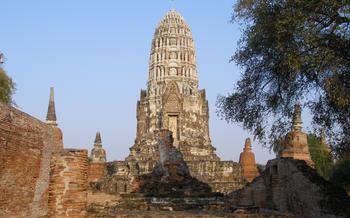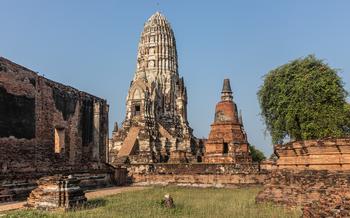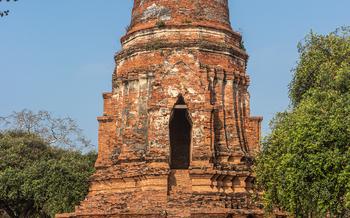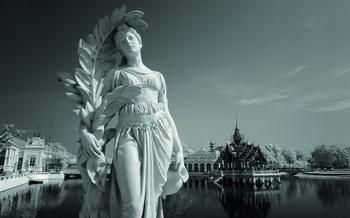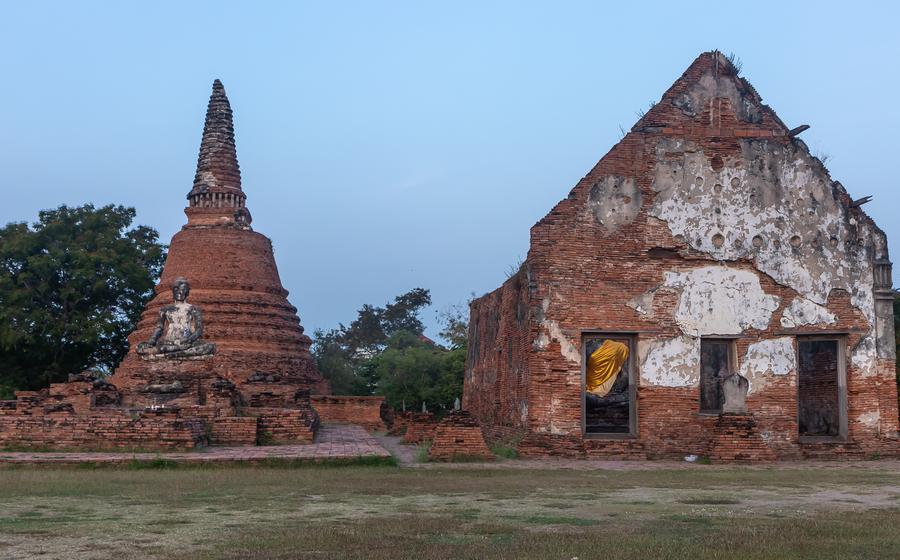
Wat Worachettharam
- Wat Worachettharam: A Stunning Historical Temple
- Exploring the Temple Grounds
- The Unique Prang Towers
- The Impressive Buddha Statues
- Visiting the Ordination Hall
- Exploring the Surrounding Areas
- Historical Significance of Ayutthaya
- The Ayutthaya Historical Park
- Transportation to Ayutthaya
- Accommodation in Ayutthaya
- Local Cuisine and Dining Options
- Cultural Activities and Events
- Responsible Tourism Practices
- Insider Tip: Hidden Gems
Wat Worachettharam: A Stunning Historical Temple
Wat Worachettharam is a stunning historical temple located in Ayutthaya, Thailand. Built in the 16th century during the reign of King Worachetthathirat, the temple is a testament to the architectural prowess and religious significance of the Ayutthaya Kingdom.
The temple's most striking feature is its unique design, which blends elements of Thai, Khmer, and Sri Lankan architectural styles. The central prang, or spire, is surrounded by four smaller prangs, creating a visually arresting composition. The temple's exterior is adorned with intricate carvings and sculptures depicting scenes from Buddhist mythology, while the interior houses a large Buddha image and numerous smaller Buddha statues.
Wat Worachettharam holds significant religious importance as a place of worship and meditation for Buddhists. The temple's design and symbolism reflect the Buddhist concept of impermanence and the cycle of rebirth. The central prang represents Mount Meru, the center of the Buddhist universe, while the surrounding prangs symbolize the four cardinal directions. The Buddha images serve as objects of devotion and inspiration, reminding visitors of the path to enlightenment.
Exploring the Temple Grounds
Wat Worachettharam's layout is a testament to the intricate planning and design that went into its construction. The temple complex is centered around a large, open courtyard, which serves as a gathering space for devotees and visitors. The courtyard is surrounded by a series of buildings, including the central prang, ordination hall, and several smaller stupas and chedis.
One of the most notable features of the temple grounds is the central prang, a tall, slender spire that dominates the skyline. The prang is decorated with intricate carvings and sculptures, depicting scenes from Buddhist mythology and the life of the Buddha. Surrounding the prang are four smaller prangs, each representing one of the four directions.
Another highlight of the temple grounds are the numerous Buddha images. These statues are found in various sizes and styles, ranging from small, seated figures to large, standing Buddhas. Each Buddha image has its own unique characteristics and symbolism, reflecting different aspects of the Buddha's teachings and life.
The temple grounds also feature several beautiful gardens and ponds, which add to the serene and peaceful atmosphere of the complex. The gardens are filled with colorful flowers and tropical plants, while the ponds are home to a variety of fish and waterfowl. These natural elements create a harmonious blend of nature and spirituality, making Wat Worachettharam a truly enchanting place to visit.
The Unique Prang Towers
The prang towers at Wat Worachettharam are a distinctive feature that sets it apart from other temples in Ayutthaya. These towers are tall, slender structures with a distinctive shape that resembles a corn cob. They are constructed from red brick and feature intricate carvings and decorations.
The architectural style of the prang towers is Khmer-influenced, reflecting the influence of the Angkorian Empire on Ayutthaya's culture and architecture. The towers are designed to represent Mount Meru, the sacred mountain at the center of the Buddhist cosmos.
The symbolic meaning of the prang towers is also significant. The central prang is said to represent the Buddha himself, while the surrounding prangs represent his disciples. The towers are also seen as symbols of the Buddha's teachings, as they point towards the sky and remind us to strive for enlightenment.
The historical significance of the prang towers is also noteworthy. They were built in the 16th century during the reign of King Borommarachathirat III. The towers were part of a larger renovation project that was undertaken by the king to restore the temple to its former glory.
Today, the prang towers are one of the most iconic features of Wat Worachettharam. They are a testament to the architectural prowess of the Ayutthaya Kingdom and a reminder of its rich cultural and religious heritage.
The Impressive Buddha Statues
Wat Worachettharam is home to a remarkable collection of Buddha statues, each possessing unique styles and symbolic meanings. The temple features various types of Buddha images, including standing, seated, and reclining postures, showcasing the rich diversity of Buddhist iconography.
One of the most striking features of the Buddha statues is their intricate iconography. The hand gestures, known as mudras, and the facial expressions convey profound spiritual messages and teachings. The Dharmachakra Mudra, representing the "turning of the wheel of dharma," is a common motif found in many of the statues.
The historical and cultural significance of the Buddha statues cannot be overstated. These statues are not merely works of art but objects of deep veneration for Buddhists worldwide. They embody the essence of Buddhist teachings and serve as a source of inspiration and devotion for countless pilgrims who visit the temple.
Visiting the Ordination Hall
The ordination hall, also known as the ubosot, is one of the most important structures within the Wat Worachettharam temple complex. It serves as the sacred space where Buddhist monks undergo ordination ceremonies, which mark their formal entry into the monastic order. The ordination hall is typically located near the center of the temple grounds and is often the largest and most elaborate building in the complex.
The ordination hall at Wat Worachettharam is a rectangular structure with a gabled roof and intricate carvings adorning its exterior walls. Inside, the hall is divided into two main sections: the ordination chamber and the antechamber. The ordination chamber is where the actual ordination ceremonies take place, and it is typically elevated slightly above the antechamber. The antechamber serves as a waiting area for monks and novices, and it often contains statues of Buddha and other religious figures.
The ordination hall is not only a place of religious significance but also a testament to the architectural and artistic achievements of the Ayutthaya Kingdom. The intricate carvings and decorations that adorn the hall's exterior and interior walls showcase the skill and craftsmanship of the artisans who built this magnificent temple.
Exploring the Surrounding Areas
Wat Worachettharam is situated amidst the Ayutthaya Historical Park, a UNESCO World Heritage Site renowned for its impressive collection of ancient temples and ruins. Take advantage of your visit to Wat Worachettharam by exploring other significant temples in the vicinity.
In close proximity to Wat Worachettharam, you'll find the majestic Wat Mahathat, known for its iconic stone Buddha head entwined by tree roots. Continue your exploration to Wat Phra Sri Sanphet, the former royal temple of the Ayutthaya Kingdom, which boasts three towering chedis that once enshrined the ashes of Ayutthayan kings.
For a unique experience, visit Wat Lokayasutharam, featuring a giant reclining Buddha statue that exudes serenity and invites contemplation. Don't miss Wat Chaiwatthanaram, an architectural masterpiece adorned with intricate carvings and stupas, reminiscent of the grandeur of the ancient Khmer Empire.
To create a well-rounded itinerary, combine your visit to Wat Worachettharam with these nearby temples. Allocate sufficient time to explore each site, immersing yourself in their rich history and architectural splendor. Consider hiring a local guide or joining a guided tour to gain deeper insights into the significance of these sacred places.
Historical Significance of Ayutthaya
Ayutthaya, once the resplendent capital of the Ayutthaya Kingdom, stands as a testament to Thailand's rich history and cultural legacy. Founded in 1350, Ayutthaya flourished for over 400 years, becoming a prominent center of trade and diplomacy. Its strategic location along the Chao Phraya River allowed it to control the flow of goods and people, making it a bustling hub of commerce.
During its reign, Ayutthaya was renowned for its architectural grandeur and artistic achievements. The city was adorned with magnificent palaces, temples, and fortifications, reflecting the kingdom's power and opulence. The Ayutthaya Kingdom also played a crucial role in shaping Thailand's cultural identity. It was here that the Thai language and literature flourished, and Theravada Buddhism became firmly established as the dominant religion.
In 1767, Ayutthaya fell to the Burmese invaders, who burned and looted the city, leaving behind only ruins. Despite its destruction, Ayutthaya's legacy lived on. The ruins of the ancient city, now a UNESCO World Heritage Site, serve as a poignant reminder of its former glory and the enduring spirit of the Thai people.
The Ayutthaya Historical Park
The Ayutthaya Historical Park, located in the city of Ayutthaya, is a UNESCO World Heritage Site that encompasses the ruins of the ancient city of Ayutthaya. The park is home to over 30 temples and other historical structures, making it one of the most important archaeological sites in Thailand.
The city of Ayutthaya was founded in 1350 and served as the capital of the Ayutthaya Kingdom for over 400 years. During this time, Ayutthaya was a major center of trade and commerce, and it was also a center of Theravada Buddhism. The city was sacked and burned by the Burmese in 1767, and it was never fully rebuilt. However, the ruins of the ancient city still stand as a testament to the glory of the Ayutthaya Kingdom.
The Ayutthaya Historical Park is a popular tourist destination, and it is easy to see why. The park is home to some of the most impressive ruins in Thailand, including the Wat Mahathat, the Wat Phra Si Sanphet, and the Wat Chaiwatthanaram. These temples are all UNESCO World Heritage Sites, and they are all worth visiting.
The Ayutthaya Historical Park is a great place to learn about the history of Thailand. The park is home to a number of museums and interpretive centers, which provide information about the Ayutthaya Kingdom and its culture. The park is also a great place to see traditional Thai dance and music performances.
If you are interested in history, culture, or architecture, then you should definitely visit the Ayutthaya Historical Park. The park is a UNESCO World Heritage Site, and it is one of the most important archaeological sites in Thailand.
Transportation to Ayutthaya
Ayutthaya is conveniently accessible from Bangkok, the capital of Thailand, and other major cities in the country. There are several transportation options available, catering to different budgets and preferences.
Train:
The train is a popular and affordable way to travel to Ayutthaya. Trains depart from Bangkok's Hualamphong Railway Station and take approximately 5 to 2 hours to reach Ayutthaya. The train journey offers a scenic and relaxing way to travel, passing through lush countryside and charming villages.
Bus:
Buses are another convenient option for getting to Ayutthaya. Several bus companies operate regular services from Bangkok's Northern Bus Terminal and Mo Chit Bus Terminal. The bus journey takes about 2 to 5 hours, depending on traffic conditions. Buses are generally more affordable than trains but may be less comfortable.
Private Car:
For those who prefer the flexibility and convenience of their own vehicle, renting a car is a good option. Ayutthaya is easily accessible by road from Bangkok and other cities. The drive takes about 1 to 5 hours, depending on the starting point. Car rental services are available at both Bangkok's Suvarnabhumi Airport and Don Mueang International Airport.
Recommendations:
For the most convenient and cost-effective option, I recommend taking the train from Bangkok. Trains are frequent, reliable, and offer a comfortable journey. If you prefer a more flexible option, renting a car is a good choice, especially if you plan to explore other nearby attractions in Ayutthaya province.
Accommodation in Ayutthaya
Ayutthaya offers a wide range of accommodation options to suit every budget and preference. From luxurious hotels to budget-friendly guesthouses and homestays, there are plenty of places to choose from. For those who want to be close to the temple and historical park, there are several hotels and guesthouses located within walking distance.
For a luxurious stay, consider the Ayutthaya Grand Hotel, which offers stunning views of the Chao Phraya River and is just a short walk from Wat Worachettharam. For a more budget-friendly option, the Baan Pomphet Guesthouse is a popular choice among backpackers and offers clean and comfortable rooms at a reasonable price.
If you're looking for a unique and authentic experience, consider staying in a homestay with a local family. This is a great way to learn about Thai culture and traditions firsthand and to get off the beaten path. There are several homestays available in Ayutthaya, and you can book them through online platforms such as Airbnb or directly with the families.
No matter what your budget or preferences, you're sure to find a comfortable and affordable place to stay in Ayutthaya. So start planning your trip today and experience the beauty and history of this ancient city.
Local Cuisine and Dining Options
Thai cuisine is renowned for its vibrant flavors, fresh ingredients, and aromatic spices. Ayutthaya offers a diverse culinary scene, from traditional Thai dishes to international fare. Visitors can savor authentic Thai flavors at local restaurants, street food stalls, and markets. Must-try dishes include Pad Thai, a stir-fried rice noodle dish with vegetables, shrimp, and chicken; Tom Yum Goong, a spicy soup with shrimp, lemongrass, and galangal; and Massaman Curry, a rich and flavorful curry with beef or chicken.
For a budget-friendly culinary experience, explore the many street food stalls scattered throughout the city. These stalls offer a variety of local delicacies, from grilled meats and seafood to sweet treats. Be sure to try the famous Ayutthaya boat noodles, a unique noodle soup served in small bowls.
When choosing a restaurant, look for places that are popular with locals. This is often a sign of good food and reasonable prices. Many restaurants in Ayutthaya also offer cooking classes, providing visitors with the opportunity to learn how to prepare their favorite Thai dishes.
Cultural Activities and Events
Ayutthaya offers a vibrant cultural scene that showcases the rich history and traditions of Thailand. Visitors can immerse themselves in the local culture through traditional Thai dance and music performances, which are often held at temples and cultural centers. These performances provide a glimpse into the country's artistic heritage and offer a captivating way to experience the vibrant energy of Thai culture.
Throughout the year, Ayutthaya also hosts a variety of local festivals and events that celebrate the city's history and traditions. These events are a great opportunity to experience the local way of life and connect with the community. From colorful processions to lively markets, there is always something happening in Ayutthaya.
For those interested in learning more about Thai culture and traditions, there are several opportunities to do so. Visitors can take cooking classes to learn how to prepare authentic Thai dishes, or participate in workshops to learn about traditional Thai crafts such as silk weaving or wood carving. These activities provide a hands-on experience and allow visitors to gain a deeper understanding of Thai culture.
Responsible Tourism Practices
As a traveler, it's essential to be mindful of the impact of tourism on local communities and the environment. When visiting Wat Worachettharam and other historical sites in Ayutthaya, there are a few responsible tourism practices to keep in mind.
First and foremost, respect the local customs and beliefs. Thailand is a predominantly Buddhist country, so it's important to be respectful of religious practices and traditions. Dress modestly, avoid loud noises, and refrain from touching Buddha images or other sacred objects.
To minimize your environmental impact, consider walking or biking instead of driving whenever possible. Many of the temples in Ayutthaya Historical Park are within walking distance of each other, and there are bike rental shops available. Reduce plastic waste by bringing your own reusable water bottle and shopping bags.
Support sustainable tourism by choosing tour operators and accommodations that are committed to responsible practices. Look for businesses that prioritize environmental conservation, cultural preservation, and community engagement.
When interacting with local people, be friendly and respectful. Learn a few basic Thai phrases, smile, and engage in polite conversation. Remember that tourism is a vital source of income for many communities, so your support is appreciated.
By following these responsible tourism practices, you can help preserve the cultural heritage of Ayutthaya and ensure that future generations can enjoy these incredible historical sites.
Insider Tip: Hidden Gems
Beyond the well-known temples of Ayutthaya, there are numerous hidden gems waiting to be discovered by curious travelers. For a truly unique experience, venture off the beaten path and explore lesser-known historical sites. Seek out the secluded Wat Phanan Choeng, with its towering prang and intricate murals depicting scenes from the Ramakien epic. Discover the serene Wat Yai Chaimongkol, home to a giant reclining Buddha statue surrounded by lush gardens. And don't miss the atmospheric Wat Mahathat, with its iconic Buddha head entwined by tree roots - a testament to the enduring power of nature. These hidden gems offer a glimpse into the rich cultural and historical tapestry of Ayutthaya, providing a deeper appreciation for this ancient city's enduring legacy.
